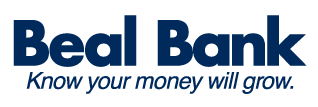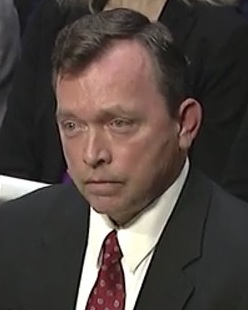
PricewaterhouseCoopers is an international professional services brand of firms, operating as partnerships under the PwC brand. It is the second-largest professional services network in the world and is considered one of the Big Four accounting firms, along with Deloitte, EY and KPMG.

The Bank of America Corporation is an American multinational investment bank and financial services holding company headquartered at the Bank of America Corporate Center in Charlotte, North Carolina. The bank was founded in San Francisco. It is the second-largest banking institution in the United States, after JPMorgan Chase, and the second largest bank in the world by market capitalization. Bank of America is one of the Big Four banking institutions of the United States. It serves approximately 10.73% of all American bank deposits, in direct competition with JPMorgan Chase, Citigroup, and Wells Fargo. Its primary financial services revolve around commercial banking, wealth management, and investment banking.
NationsBank was one of the largest banking corporations in the United States, based in Charlotte, North Carolina. The company named NationsBank was formed through the merger of several other banks in 1991, and prior to that had been through multiple iterations. Its oldest predecessor companies had been Commercial National Bank (CNB), formed in 1874, and American Trust Company founded in 1909. In 1998, NationsBank acquired BankAmerica, and modified that better-known name to become Bank of America.

The PNC Financial Services Group, Inc. is an American bank holding company and financial services corporation based in Pittsburgh, Pennsylvania. Its banking subsidiary, PNC Bank, operates in 27 states and the District of Columbia, with 2,629 branches and 9,523 ATMs. PNC Bank is on the list of largest banks in the United States by assets and is one of the largest banks by number of branches, deposits, and number of ATMs.

SunTrust Banks, Inc. was an American bank holding company with SunTrust Bank as its largest subsidiary and assets of US$199 billion as of March 31, 2018. The bank's most direct corporate parent was established in 1891 in Atlanta, where it was headquartered.

National City Corporation was a regional bank holding company based in Cleveland, Ohio, USA, founded in 1845; it was once one of the ten largest banks in America in terms of deposits, mortgages and home equity lines of credit. Subsidiary National City Mortgage is credited for doing the first mortgage in America. The company operated through an extensive banking network primarily in Ohio, Illinois, Indiana, Kentucky, Michigan, Missouri, Pennsylvania, Florida, and Wisconsin, and also served customers in selected markets nationally. Its core businesses included commercial and retail banking, mortgage financing and servicing, consumer finance, and asset management. The bank reached out to customers primarily through mass advertising and offered comprehensive banking services online. In its last years, the company was commonly known in the media by the abbreviated NatCity, with its investment banking arm even bearing the official name NatCity Investments.

Regions Financial Corporation is an American bank holding company headquartered in the Regions Center in Birmingham, Alabama. The company provides retail banking and commercial banking, trust, stockbrokerage, and mortgage services. Its banking subsidiary, Regions Bank, operates 1,952 automated teller machines and 1,454 branches in 16 states in the Southern and Midwestern United States.

OneWest Bank, a division of First Citizens BancShares, is a regional bank with over 60 retail branches in Southern California. OneWest Bank specializes in consumer deposit and lending including personal checking and savings accounts, Money Market accounts, CDs, and home loan products. OneWest also offers small business checking, savings, CD and money market accounts as well as small business loans and treasury management products.

Beal Bank is an American bank, which was founded by Texas-based entrepreneur D. Andrew "Andy" Beal. It includes two separately chartered banks, Beal Bank and Beal Bank USA. Each entity is insured by the Federal Deposit Insurance Corporation (FDIC).

Colonial BancGroup Inc. was a bank holding company headquartered in Montgomery, Alabama, United States that failed in 2009. It was a financial services company that, through its subsidiaries, provided diversified services, including retail and commercial banking, wealth management services, mortgage banking and insurance. The company was in the top 50 largest banks in the US prior to its failure and its subsidiary, Colonial Bank, operated 346 branches in the states of Alabama, Georgia, Florida, Nevada and Texas.

New York Community Bancorp, Inc. (NYCB) is a bank headquartered in Westbury, New York with 225 branches in New York, New Jersey, Ohio, Florida and Arizona. NYCB is on the list of largest banks in the United States.
IndyMac, a contraction of Independent National Mortgage Corporation, was an American bank based in California that failed in 2008 and was seized by the United States Federal Deposit Insurance Corporation (FDIC).

EverBank, now TIAA Bank, is an American diversified financial services company providing banking, mortgages, and investing services. It is based in Jacksonville, Florida, U.S. It operates through standard banking offices and through its Direct Banking division. EverBank Direct operates by telephone, mail, and over the Internet. As of September 30, 2015, EverBank had approximately $25.2 billion in total assets.

Taylor, Bean & Whitaker was a top-10 wholesale mortgage lending firm in the United States, the fifth-largest issuer of Government National Mortgage Association securities. Their slogan was "Perfecting the Art of Mortgage Lending".
The government interventions during the subprime mortgage crisis were a response to the 2007–2009 subprime mortgage crisis and resulted in a variety of government bailouts that were implemented to stabilize the financial system during late 2007 and early 2008.
The 1921 Alabama Crimson Tide football team represented the University of Alabama in the 1921 college football season. It was the Crimson Tide's 28th overall and 25th season as a member of the Southern Intercollegiate Athletic Association (SIAA). The team was led by head coach Xen C. Scott, in his third year, and played their home games at Denny Field in Tuscaloosa and at Rickwood Field in Birmingham, Alabama. They finished the season with a record of five wins, four losses and two ties.
The 1922 Alabama Crimson Tide football team represented the University of Alabama in the 1922 college football season. It was the Crimson Tide's 29th overall and 1st season as a member of the Southern Conference (SoCon). The team was led by head coach Xen C. Scott, in his fourth year, and played their home games at Denny Field in Tuscaloosa, Rickwood Field in Birmingham and the Cramton Bowl in Montgomery, Alabama. They finished the season with a record of six wins, three losses and one tie.
Guaranty Bank was a bank based in Milwaukee, Wisconsin. It had 119 branches, 107 of which were kiosks in grocery stores and Walmart Supercenters. The bank operated in five states: Wisconsin, Illinois, Michigan, Minnesota, and Georgia. The bank also operated locations under the name BestBank. On Friday, May 5, 2017, as a result of bank failure, the bank was shut down by the Office of the Comptroller of the Currency. It was placed into receivership and the Federal Deposit Insurance Corporation was named receiver. The assets of the bank were sold to First Citizens BancShares.

Ameris Bancorp is a bank holding company headquartered in Atlanta. Through its bank subsidiary, Ameris Bank, the company operates full-service branches in Georgia, Alabama, Florida, North Carolina and South Carolina, and mortgage-only locations in Georgia, Alabama, Florida, North Carolina, South Carolina, Virginia, Maryland, and Tennessee.

Christopher Robert Sharpley was the Acting Inspector General of the Central Intelligence Agency (CIA) from 2015 to 2017. He was nominated by President Donald Trump in September 2017 to become Inspector General of the CIA but failed to receive confirmation in the United States Senate.














